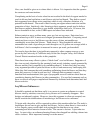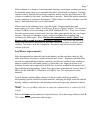
Page 4
The origin of the leaf blower:
The leaf blower has been around for more than 35 y
The original blower was designed to spread fertilize
and pesticides over grain fields and fruit trees. A
container was mounted above a centrifugal fan as the
source for the chemicals that would be disbursed evenly
over the area. Versions of this product are still in use
today. Echo’s name for this device was and is the
“Duster-Mister”. It was discovered, back in the 1970’s
that this blower, less the chemical container, would
make an excellent leaf blower, which of course is where
it got its name.
ears.
rs
Leaf blower use:
Today, there are many uses for the leaf blower, including the cleaning of driveways and
sidewalks after cutting the grass and the removal of debris from parking lots, sports
arenas, city parks and construction sites. It quickly became an important cleanup tool,
saving time over alternative methods. It turns out that this product does a far better job
than a rake or broom and at far less cost due to the speed in which it can clean up an area.
The Department of Public Services for the City of Coronado, CA conducted a test
comparing brooms to leaf blowers. To clean the perimeter sidewalk of a downtown park
with a broom took 80 minutes where it took only 6 minutes to clean with a blower. The
leaf blower has become indispensable. Clearly, it is not just a leaf blower. It is an all-
purpose outdoor clean up tool.
Note: A leaf blower is NOT intended for use on gravel driveways, dry dirt or other
potentially dusty surfaces.
How serious is the leaf blower problem?
In recent years, there have been several cities around the United States that have taken
steps to regulate blowers. In 1998, the city of Los Angeles passed an ordinance that
prohibits the use of leaf blowers within 500 feet of a personal residence. There have been
other attempts at banning in both large and small cities, but so far, most have failed.
They either didn’t get passed by the city council or after passing, could not be enforced.
Still banning can be a serious problem depending on the penalty associated with violating
the ban and the persistence of the local police force.
Powerful entities have looked into banning blowers. In 2000, the California State
Legislature instructed the California Air Resources Board (CARB) to conduct a study on
the environmental impact of leaf blowers based on information and test results available
at the time. The report from this study made a clear statement that there are many
individuals, organizations and municipalities deeply bothered by the leaf blower.















